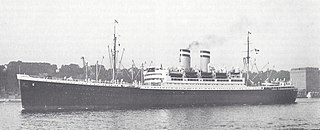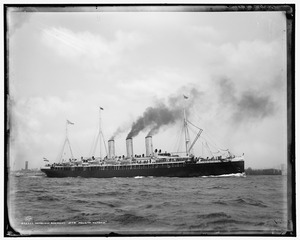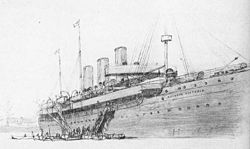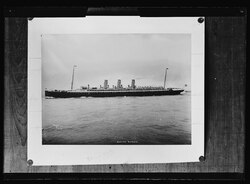
Kaiser Wilhelm der Grosse was a German transatlantic ocean liner in service from 1897 to 1914, when it was scuttled in battle. It was the largest ship in the world for a time, and held the Blue Riband until Cunard Line’s RMS Lusitania entered service in 1907. The vessel’s career was relatively uneventful, despite a refit in 1913.

Albert Ballin was a German shipping magnate. He was the general director of the Hamburg-Amerikanische Packetfahrt-Actien-Gesellschaft (HAPAG) or Hamburg-America Line, which for a time was the world's largest shipping company. Being the inventor of the concept of the cruise ship, he is known as the father of modern cruise ship travel. Albert Ballin was a risk-taker who was willing to challenge his colleagues, foreign competitors, and domestic politics in order to build a successful shipping company. He focused on British rivals and was determined to expand HAPAG's global reach, he also worked closely with the Kaiser and supported expansion of the German navy.

The Blue Riband is an unofficial accolade given to the passenger liner crossing the Atlantic Ocean in regular service with the record highest average speed. The term was borrowed from horse racing and was not widely used until after 1910. The record is based on average speed rather than passage time because ships follow different routes. Also, eastbound and westbound speed records are reckoned separately, as the more difficult westbound record voyage, against the Gulf Stream and the prevailing weather systems, typically results in lower average speeds.

An ocean liner is a type of passenger ship primarily used for transportation across seas or oceans. Ocean liners may also carry cargo or mail, and may sometimes be used for other purposes. Only one ocean liner remains in service today.

SS Albert Ballin was an ocean liner of the Hamburg-America Line launched in 1923 and named after Albert Ballin, the visionary director of the Hamburg-America line, who had committed suicide several years earlier. In 1935, the ship was renamed Hansa on orders from the German government. Towards the end of World War II, she was employed to evacuate civilians during Operation Hannibal, and sank after hitting a mine. She was later raised and refitted by the Soviet Union and was finally scrapped in 1982.

Augusta Viktoria of Schleswig-Holstein was the last German Empress and Queen of Prussia by marriage to Wilhelm II, German Emperor.

The Hamburg-Amerikanische Packetfahrt-Aktien-Gesellschaft (HAPAG), known in English as the Hamburg America Line, was a transatlantic shipping enterprise established in Hamburg, in 1847. Among those involved in its development were prominent citizens such as Albert Ballin, Adolph Godeffroy, Ferdinand Laeisz, Carl Woermann, August Bolten, and others, and its main financial backers were Berenberg Bank and H. J. Merck & Co. It soon developed into the largest German, and at times the world's largest, shipping company, serving the market created by German immigration to the United States and later, immigration from Eastern Europe. On 1 September 1970, after 123 years of independent existence, HAPAG merged with the Bremen-based North German Lloyd to form Hapag-Lloyd AG.
Aktien-Gesellschaft Vulcan Stettin was a German shipbuilding and locomotive building company. Founded in 1851, it was located near the former eastern German city of Stettin, today Polish Szczecin. Because of the limited facilities in Stettin, in 1907 an additional yard was built in Hamburg. The now named Vulcan-Werke Hamburg und Stettin Actiengesellschaft constructed some of the most famous civilian German ships and it played a significant role in both World Wars, building warships for the Kaiserliche Marine and the Kriegsmarine later.

Majestic was a British Ocean liner working on the White Star Line’s North Atlantic run, originally launched in 1914 as the Hamburg America Liner SS Bismarck. At 56,551 gross register tons, she was the largest ship in the White Star Line and the largest ship in the world until completion of SS Normandie in 1935.

Deutschland was a passenger liner built in Stettin and launched on 10 January 1900 for the Hamburg America Line (HAPAG) of Germany. She was officially the second ocean liner to have four funnels on the transatlantic route, the first being Kaiser Wilhelm der Grosse of 1897.

SS Cap Trafalgar was a German ocean liner launched in 1913 for the Hamburg Süd line. In 1914, she was converted for use as an auxiliary cruiser during World War I. She was the first armed merchant cruiser sunk by a ship of the same class; she was destroyed by HMS Carmania, also a converted ocean liner, in a furious action in the South Atlantic on 14 September 1914. It was the world's first battle between former ocean liners.

RMS Empress of Australia was an ocean liner built in 1913–1919 by Vulcan AG shipyard in Stettin, Germany for the Hamburg America Line. She was refitted for Canadian Pacific Steamships; and the ship – the third of three CP vessels to be named Empress of China – was renamed yet again in 1922 as Empress of Australia.

SS Oronsay was the second Orient Line ship built after World War II. A sister ship to Orcades, she was named after the island of Oronsay off the west coast of Scotland.

Prinzessin Victoria Luise was the World's first purpose-built cruise ship. She was built in Germany, and launched in 1900 for Hamburg America Line (HAPAG).

USS Mercury (ID-3012) was a United States Navy transport ship during World War I. She was formerly the Norddeutscher Lloyd liner SS Barbarossa built by Blohm & Voss, Hamburg, Germany, in 1897, and operated by the North German Lloyd Line.

RMS Empress of Scotland, originally SS Kaiserin Auguste Victoria, was an ocean liner built in 1905–1906 by Vulcan AG shipyard in Stettin for the Hamburg America Line. The ship regularly sailed between Hamburg and New York City until the outbreak of war in Europe in 1914. At the end of hostilities, re-flagged as USS Kaiserin Auguste Victoria, she transported American troops from Europe to the United States. For a brief time Cunard sailed the re-flagged ship between Liverpool and New York.

SS Prinz Friedrich Wilhelm was an ocean liner for North German Lloyd (NDL) from her launch in 1907 until the end of World War I. After the war, she briefly served as USS Prinz Friedrich Wilhelm (ID-4063) for the United States Navy returning American troops from France. The vessel was first chartered—and later purchased outright—by Canadian Pacific Steamships (CP) and operated under the names Empress of China, Empress of India, Montlaurier, Monteith, and Montnairn. She was scrapped in 1929.

The Imperator-class ocean liners were a series of three ocean liners designed for the Hamburg America Line, commonly known as HAPAG. These three ships were commissioned by the chairman of HAPAG Albert Ballin. Namely the Imperator (1912), the Vaterland (1913) and the largest, the Bismarck (1914). These liners were over 50,000 tons, sported three funnels and had a length ranging from 906 to 956 feet. Vaterland is the largest passenger ship ever operated by a German shipping company.

The Rivers class was a class of eleven ocean liners of the Norddeutscher Lloyd (NDL), the first class of German express liners. The ships were built between 1881 and 1890, the first nine in Glasgow by John Elder & Co. or the renamed Fairfield Shipbuilding and Engineering Company, the last two in Stettin by Vulcan. All were named for rivers in Germany.

SS New York was a German passenger liner launched in 1926 for the Hamburg-America Line and was the sister to the SS Albert Ballin, SS Deutschland, and SS Hamburg. During World War II the ship continued its passenger service until in 1940, the Kriegsmarine requisitioned it as a accommodation ship for the war. The ship was sunk in an air raid at Kiel in 1945.





















